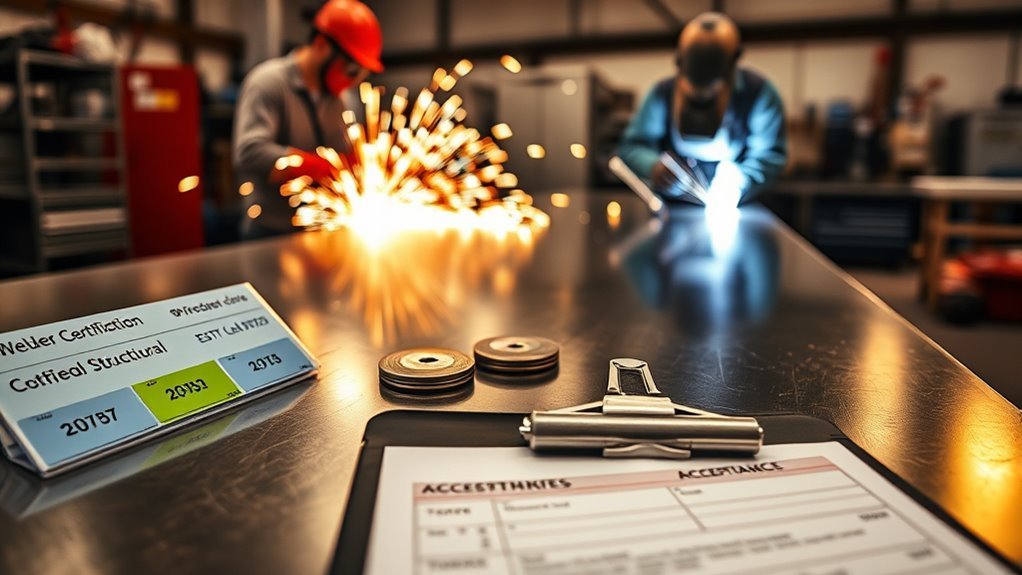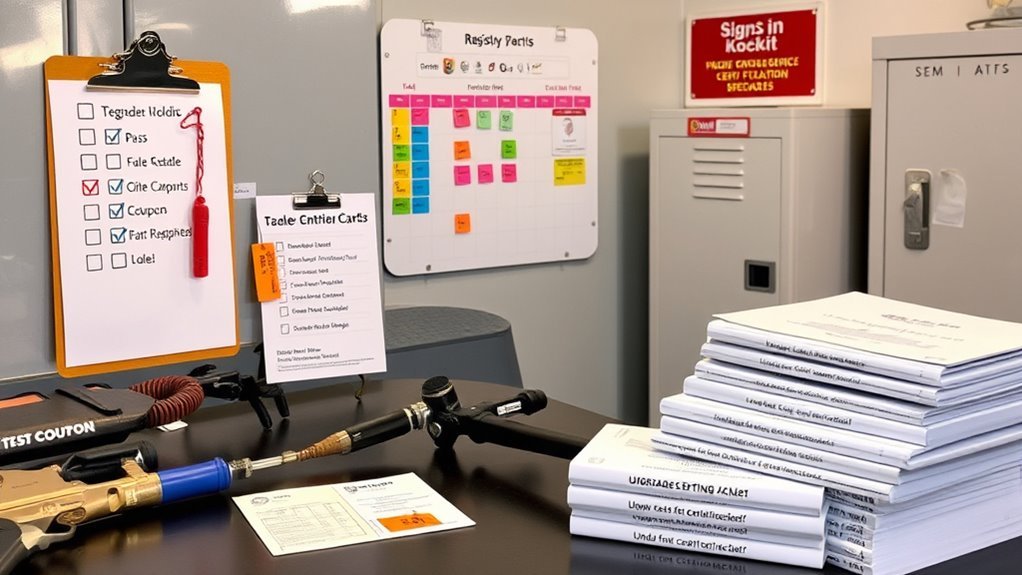Most people don’t realize that the sticker price for a welding cert often covers only the test itself, not the prep, PPE, or retest fees you’ll likely need. You’ll want to know how AWS, ASME, and employer-specific tests differ in scope and safety standards, what gear and materials you must bring, and how ATF upgrades or registry entries add cost — keep this in mind as you decide where and when to get certified.
Typical Certification Types and What They Cost

When you prepare for welding certification, prioritize which standard matches your work: AWS D1.1 covers structural steel (common thicknesses like 3/8″ and 1″ in vertical and overhead positions).
When preparing for welding certification, match the standard to your work: AWS D1.1 covers structural steel and common vertical/overhead thicknesses.
ASME Section IX governs pressure-boundary and code work (including the 6G position using Stick/MIG or TIG), and many test centers also offer send-in kits if you can’t test on-site.
You’ll choose certification types based on application: AWS D1.1 for structural, ASME IX for pressure-boundary, or a send-in kit when travel’s impractical.
For AWS D1.1, expect $460 for a 3/8″ vertical/overhead test and $520 for a 1″ test; ATF upgrades increase those to $615 and $685 respectively.
ASME IX 6G testing using Stick/MIG or TIG is $460, with retests at $120 per position. If you fail AWS D1.1, retesting runs $250 per position.
Use these cost comparisons to plan the appropriate test, prioritize safety protocols, and comply strictly with the governing standard.
Breakdown of Additional Expenses to Budget For

Budgeting for welding certification goes beyond test fees — you’ll need to plan for materials, safety gear, equipment, study resources, and possible retests.
Account for gloves, helmets, jackets, respirators and consumables: these budgeting essentials typically run $100–$500 depending on quality and standards you follow. If you’ll practice at home or work, a welding machine is a major line item — expect $500–$2,000 for reliable, code-capable units.
Include books, coursework and supplies ($100–$500) and the realistic possibility of retest fees, usually $120–$250 per position.
If you attend a program away from home, factor room and board at $5,000–$15,000 per academic year; treat this as part of long-term expense management rather than an add-on.
Prioritize safety-rated gear and maintenance of equipment to meet certification standards.
Track costs in categories, set contingency for retesting, and review expenses regularly so your budget stays aligned with certification requirements.
Scheduling, Locations, and Test Day Requirements

You’ll need to schedule your welder certification test for a Tuesday or Thursday at 8:00 AM by phone or inquiry submission to reserve a spot.
On test day bring a photo ID and all required safety gear, and be prepared to follow site-specific standards at one of the locations (Baltimore, Beltsville, York, Scranton, Southern MD, or Arnold MD).
Check the testing locations map before you go and note retest options and fees if you don’t pass.
Test Dates & Times
Need to know when to show up? You’ll plan test preparation and testing logistics around set dates: welder certification tests run Tuesdays and Thursdays, starting promptly at 8:00 AM.
You must schedule an appointment by phone or inquiry submission before the test day. Testing sites include Baltimore, MD; Beltsville, MD; York, PA; Scranton, PA; Southern MD Welding School; and Arnold MD Welding School.
Stay alert for weather-related closures or delays via designated channels.
- Confirm appointment and arrival time at your chosen location.
- Verify local directions and parking to avoid delays.
- Check weather notices the morning of the test.
- Bring required identification and safety equipment as instructed.
Arrive early, follow safety protocols, and stick to standards-driven procedures.
Required Test Items
Because testing runs on fixed days and starts promptly at 8:00 AM, you must schedule an appointment in advance and arrive prepared with the required items and PPE to meet safety and qualification standards.
Tests are offered on Tuesdays and Thursdays; book by phone or inquiry submission and confirm your chosen facility.
Test day essentials include a government-issued photo ID and your personal safety gear — helmet, gloves, jacket, and safety glasses — that meet facility and AWS requirements.
Know that retesting carries a $250 fee per position. If you want AWS registry enrollment and a wallet card, add the AWS ATF Upgrade for an extra charge.
Follow site instructions precisely to avoid disqualification or delays.
Testing Locations Map
Multiple convenient testing locations across Maryland and Pennsylvania run welder certification sessions on Tuesdays and Thursdays, starting promptly at 8:00 AM.
So plan and book your appointment in advance by phone or inquiry to secure a slot at Baltimore, Beltsville, York, Scranton, Southern MD Welding School, or Arnold MD Welding School.
You’ll confirm certification availability when you call or submit an inquiry; schedules fill quickly, so pick your site early.
On test day, bring a photo ID and required PPE; testers follow strict safety and AWS-aligned procedures.
Retest options cost $250 per position for most exams. The ATF Upgrade is optional for an added fee and registers you in the AWS certified welder registry with an AWS card.
- Confirm testing locations and dates before travel
- Bring picture ID and safety gear
- Expect standards-driven inspection and scoring
- Budget for retest or ATF Upgrade fees
Retests, ATF Upgrades, and Registry Options

When your initial weld test falls short, you’ll pay $250 per position to retest under most certification codes, with ASME IX retests set at $120 per position regardless of process; you can also opt for an AWS Accredited Test Facility (ATF) Upgrade for an additional $155 to have your result entered in the AWS certified welder registry and receive an AWS card, which improves credential portability and confirms you met AWS standards. You should track retest pricing and certification benefits to plan follow-up attempts. ASME IX’s lower retest fee applies uniformly; AWS D1.1 test fees vary (for example, 3/8″ vertical/overhead $460, 1″ $520, excluding upgrades). Opting for the ATF upgrade makes your credential verifiable to employers and safety inspectors, supporting compliance and mobility. Maintain documentation, note position-specific requirements, and verify registry entry after passing. Below is a quick reference table.
| Item | Fee |
|---|---|
| Retest (most codes) | $250 |
| ASME IX retest | $120 |
Financial Aid, Scholarships, and Cost-Saving Strategies

Looking to reduce the sticker shock of welding certification? You can combine targeted financial aid options with disciplined planning to protect safety training and meet industry standards without overspending.
Federal grants and low-interest loans cover tuition gaps; review eligibility early so you don’t delay enrollment or required safety coursework. Seek scholarship opportunities from schools, professional associations, and employers to lower direct costs and fund PPE or certification exams.
- Apply to American Welding Society and association scholarships tied to standards-based competitions.
- Prioritize community college programs (often ~ $5,000 for two years) for foundational, accredited training.
- Stack grants, scholarships, and modest federal loans to minimize debt while guaranteeing full skills coverage.
- Use employer tuition assistance or apprenticeship stipends to offset exam, retest, and equipment expenses.
Track deadlines, document safety certifications, and verify program accreditation to guarantee your funding aligns with recognized welding competency requirements.
Career Value: Salary Expectations and Return on Investment

You’ll want to compare local salary ranges — in Detroit, welder-fabricators average about $41,860 annually, with experienced specialists reaching up to $71,200 — against certification costs of roughly $460–$685.
Calculate payback time by dividing the certification expense by your expected wage premium from becoming certified and moving into higher-demand sectors.
Prioritize certifications recognized by standards bodies like AWS so your investment remains portable and maximizes long-term safety-focused career growth.
Salary Range Expectations
Although pay varies by experience, certification, and industry, you can expect welder salaries to range from entry-level wages in the high $20,000s to mid-to-upper $40,000s median pay, with metropolitan areas like Detroit averaging about $41,860 and top earners exceeding $70,000.
You’ll find salary expectations tied to certification level, specialized skills, and adherence to safety and welding standards. Certified welders command higher earning potential and clearer advancement paths.
Consider these factors when evaluating job offers and training costs:
- Entry-level: basic certifications, hands-on supervision, lower pay, on-the-job safety training
- Certified/specialized: higher rates, stricter quality standards, access to aerospace/oil & gas roles
- Supervisory/inspection: leadership pay premiums
- Geographic demand: metropolitan and industry hubs pay more
Investment Payback Time
Because certification directly ties to measurable pay gains and clearer advancement paths, you can calculate a realistic payback window for most welding credentials by comparing certification costs ($460–$685) against local salary differentials and promotion timelines. You’ll use Detroit’s average welder-fabricator pay (~$41,860) and entry-to-advanced ranges to estimate how many months until certification pays for itself. Focus on measurable certification benefits: higher starting bids, specialty sector access, and faster promotions. Track investment duration by projecting incremental monthly salary gains after certification. Use standards-driven metrics (percent increase, extra hours billed, promotion frequency) to compute ROI and verify safety-qualified competence that employers value.
| Metric | Example |
|---|---|
| Cost | $460–$685 |
| Payback | 3–18 months |
Frequently Asked Questions
What Certifications Are Recognized Internationally Versus Only in the U.S.?
International certifications like ISO/ASME are widely accepted; U.S. certifications such as AWS often apply domestically. You’ll follow safety-focused, standards-driven procedures, ensuring qualifiers meet employer or project-specific requirements and regional code equivalency.
Can Prior Military Welding Experience Reduce Certification Requirements?
Yes — your military experience can reduce certification requirements: you’ll need documented training and weld tests, but accrediting bodies often grant waivers or expedited paths, preserving safety standards and certification benefits when qualifications match civilian codes.
Are There Online or Remote Welding Certification Options?
Yes, you can—sometimes online welding programs pair with remote certification tests, and you’ll follow rigid standards, complete safety-focused coursework, submit video welds, and schedule supervised testing to meet detailed, accredited qualification requirements.
Do Certification Costs Include Equipment Maintenance or Replacement?
No — certification fees typically cover testing and administration; they don’t include equipment costs or ongoing maintenance fees. You’ll need to budget separately for tool upkeep, replacements, and calibration to meet safety and standards requirements.
How Long Do Certifications Remain Valid Before Renewal?
Certifications typically remain valid 1–5 years depending on code and employer; you’ll follow a formal renewal process involving retesting, documentation, or continuous training to meet certification duration, safety standards, and quality-controlled renewal process.
Conclusion
You now know typical fees, extra gear and study costs, and retest or ATF upgrade charges — but is the investment worth it? Yes: by following safety-focused training, meeting AWS/ASME standards, and budgeting for materials, testing, and possible retests, you’ll protect yourself and boost employability. Plan for $460–$685 per test plus $100–$15,000 in additional expenses, track certifications on registries, and pursue aid or employer support to lower out-of-pocket risk.


